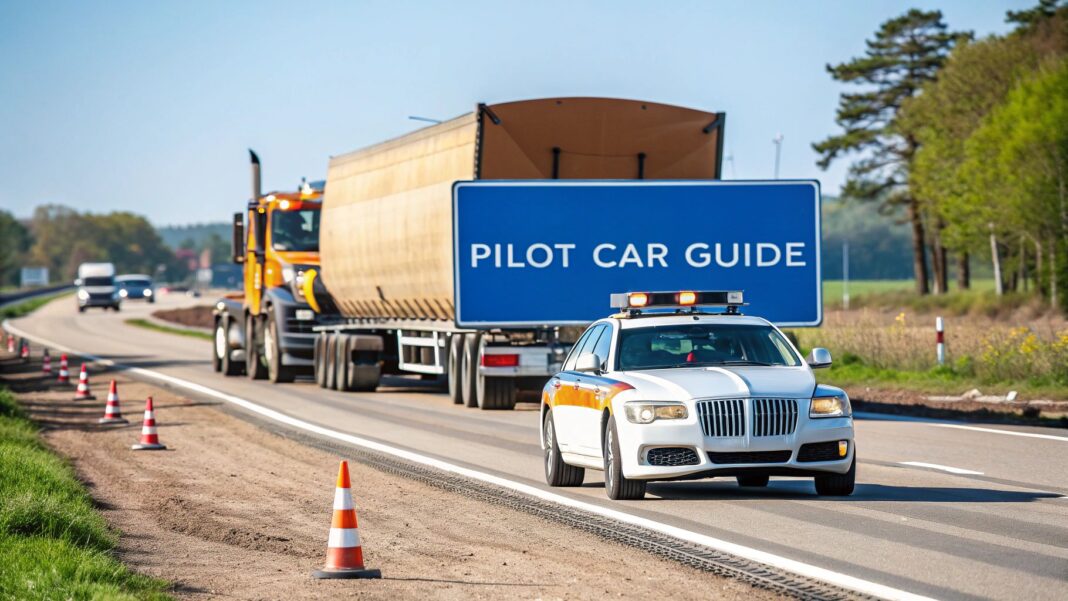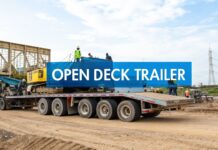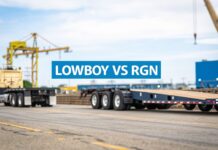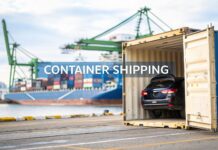
When you see a truck hauling something enormous—like a wind turbine blade or a prefabricated building module—you'll almost always see smaller vehicles with flashing lights escorting it. These are pilot cars, and they are an essential component of heavy haul trucking.
Think of them as the strategic eyes and ears for the truck driver. They scout the route ahead, manage traffic from the rear, and create a protective bubble around the massive cargo. Their primary mission is to ensure the load, the driver, and the public all remain safe throughout the entire journey.
The Role of Pilot Cars in Safe Transport

Maneuvering a building-sized piece of equipment through public roads is a high-stakes operation. The truck driver's visibility is severely restricted, and they cannot react to sudden hazards with the agility of a standard vehicle. This is precisely where pilot cars provide their critical transport value.
These escort vehicles are far more than just cars with flashing lights; they function as a mobile intelligence and safety unit. They perform critical tasks that are fundamental to a safe and successful transport operation. Their job is to mitigate risk by identifying and neutralizing potential problems long before the oversized load encounters them.
A Mobile Command Center on the Road
A professional pilot car team functions as a coordinated unit, constantly communicating and reacting to challenges in real-time. Their core responsibilities provide direct, actionable support to the transport:
- Proactive Route Scouting: The lead pilot car drives ahead to identify upcoming hazards. They look for low-hanging power lines, narrow bridges, unannounced road construction, or sharp turns that could halt the entire operation. This allows the truck driver to prepare or stop well in advance.
- Active Traffic Management: Both lead and chase cars use signs and lights to alert other drivers to the oversized load. They create a secure buffer zone, directing traffic and preventing other vehicles from making unsafe maneuvers that could lead to collisions.
- Real-Time Communication: The pilot car driver is in constant radio contact with the truck driver, relaying specific instructions and information about road conditions, upcoming hazards, and the optimal path through a tricky intersection.
This proactive strategy is the key to a successful haul. An analysis of late-2023 transport data showed that 89% of potential delays were prevented by effective escort teams, while the same data revealed a 22% reduction in transport costs due to improved route execution and fewer incidents.
The presence of a pilot car transforms a high-risk journey into a controlled, choreographed operation. It is a direct investment in safety and efficiency that protects the public, the cargo, and vital infrastructure.
Understanding the function of these escort vehicles is the first step in planning successful heavy haul logistics. For a comprehensive overview of the entire process, explore our detailed guide on transporting oversized loads. Their involvement ensures every mile is executed safely and according to a well-defined plan.
When Are Pilot Cars Actually Required?
Determining if you need pilot cars for oversized loads is a critical step in your transport planning. There is no single national standard; instead, regulations are a complex patchwork of state and local rules that dictate when an escort vehicle is a legal necessity.
The primary triggers are almost always the load's dimensions—specifically its width, height, and length. Each state establishes its own legal limits, and if your cargo exceeds them, you are legally required to hire an escort. These regulations can vary significantly from one state to the next, a critical planning detail for any interstate transport.
The Most Common Triggers
While the exact numbers differ, certain dimensions should immediately signal the need for a professional assessment of escort requirements.
- Width: This is the most common trigger. If your load exceeds 12 feet in width, it is highly probable that at least one pilot car will be required by law.
- Height: For tall loads, particularly those exceeding 14 feet 6 inches, a height-pole escort is often mandated to physically verify clearance under bridges and power lines.
- Length: For exceptionally long loads like wind turbine blades or bridge girders, escorts become essential once the overall length surpasses the 80 to 85-foot range to help navigate turns safely.
This visual provides a clear illustration of how much width requirements can vary by state.

As you can see, a load that is legal without an escort in one state may require one as soon as it crosses into another. This makes route planning and permit acquisition crucial.
To provide a practical overview of this regulatory landscape, here are some common thresholds. Remember, these are general guidelines and are subject to change, but they highlight the state-by-state due diligence required.
State-by-State Pilot Car Requirement Thresholds
| State | Width Trigger (Approx.) | Height Trigger (Approx.) | Length Trigger (Approx.) | Actionable Insight |
|---|---|---|---|---|
| Florida | 12' | 14' 6" | 80' | Plan for strict enforcement; specific certifications for escorts are required. |
| Texas | 14' | 18' 11" | 110' | While limits are higher, rules for "super loads" are complex and require detailed planning. |
| California | 12' | 14' | 80' | Requirements can vary by specific highway and time of day; verify the route carefully. |
| Georgia | 12' | 14' 6" | 100' | Be aware of potential nighttime and holiday travel restrictions for escorted loads. |
| Pennsylvania | 13' | 14' 6" | 85' | Mountainous terrain means strict rules on specific routes; pre-planning is essential. |
This table underscores a key transport principle: your planning must be based on the regulations of the strictest state on your route, not just your origin.
It's Not Always Just About the Dimensions
While size is the primary factor, other conditions can mandate an escort. A significant overhang, where cargo extends far beyond the rear of the trailer, often requires a chase car to prevent rear-end collisions and ensure other drivers maintain a safe following distance.
Additionally, the route itself can be a factor. Navigating a dense urban area with tight turns and heavy traffic may require a pilot car for a load that wouldn't need one on an open highway.
The guiding principle for transport managers is this: if a shipment’s size or route creates a tangible risk to the public or infrastructure, a pilot car is the designated tool to manage that risk effectively.
The most reliable way to ensure compliance is to work with a logistics expert who navigates these regulations daily. Securing the correct permits is the foundational step of the entire operation. For a detailed breakdown of the necessary paperwork, our guide on oversize transport permits is an excellent resource.
Breaking Down the Costs of Pilot Car Services

When budgeting for pilot cars for oversized loads, looking only at a simple hourly or per-mile rate can be misleading. The final cost is an aggregation of several factors, and understanding them is crucial for creating an accurate transport budget.
Most pilot car companies quote jobs based on a per-mile rate for shorter trips or a daily flat rate for longer, multi-day hauls. In either case, this base rate is only the starting point for your total cost calculation.
Key Factors That Influence the Final Price
The final cost is almost always driven by the complexity and duration of the transport. The more time and resources a job requires, the higher the price will be.
Here are the primary cost drivers to consider:
- Total Distance and Duration: Longer trips directly increase costs. A multi-day journey will also include expenses for driver lodging and meals (per diem), which a single-day job will not have.
- Number of Escorts Required: State regulations and the specific dimensions of your load dictate whether you need one, two, or even more pilot cars. Each additional vehicle and certified operator is a direct multiplier of the base cost.
- Interstate Travel Complexity: Crossing state lines introduces significant logistical challenges. Each state has its own permit requirements and certification standards for pilot car operators. This can necessitate swapping escort teams mid-route, adding a layer of complexity and cost.
Pilot car operation is a skilled profession with significant responsibility. To put this in perspective, in early 2025, the average annual salary for an oversize load pilot car operator in the United States was estimated to be $134,863. This figure reflects the high level of expertise required. You can explore salary insights for more detail on how compensation varies by location and experience.
Uncovering the Hidden and Overlooked Costs
Beyond the base rate, several other fees can impact your final invoice. Being aware of these potential charges allows you to ask the right questions upfront and build a more realistic budget.
It's the unanticipated costs that can derail a transport budget. A comprehensive quote should account for every potential expense, from the first mile to the pilot car's return trip.
Be prepared for these often-overlooked charges in your transport plan:
- "Deadhead" Miles: This industry term refers to the miles the pilot car driver travels to get from their base to your pickup location, and from the delivery point back home. These miles are almost always billable.
- Overnight Layovers: For multi-day hauls, you are responsible for the pilot car operator's lodging costs and a daily "per diem" allowance to cover meals and incidentals.
- Specialized Equipment Surcharges: If your load requires a height pole to check for low clearances, there will be an additional fee for both the specialized equipment and the trained operator required to use it effectively.
What a Professional Pilot Car Operation Looks Like
A professional pilot car operation is far more than a standard vehicle with a flashing light. It is a mobile command center equipped for safety and communication, operated by a trained professional. The real value is delivered through the combination of specialized equipment and the operator's expertise.
A top-tier escort vehicle is equipped for maximum visibility and constant communication. Every piece of equipment has a specific, critical function designed to mitigate risk and ensure the safe passage of the oversized load.
The Essential Onboard Equipment
The equipment on a pilot car is not optional; it is regulated and essential for safe operation. Each item plays a specific role in managing the logistics of moving a massive object on public roads.
- High-Visibility Banners and Flags: Bright yellow "OVERSIZE LOAD" banners on the front and back, paired with red or orange flags, are the primary visual warning for other drivers.
- Amber Beacon Lights: The powerful, flashing amber beacon provides a 360-degree warning visible from a significant distance, signaling to other motorists that they need to proceed with caution.
- Communication Radios: A reliable CB radio is the communication lifeline between the pilot car and the truck. It enables instant, clear commands about upcoming hazards, traffic adjustments, or the immediate need to pull over.
For tall loads, the most critical piece of equipment is the height pole. This is a non-conductive, flexible pole mounted on the lead car's front bumper, calibrated to be slightly higher than the load. If the pole makes contact with a low bridge or power line, it provides an immediate physical warning for the convoy to stop, preventing a potentially catastrophic collision.
The Human Element That Makes the Difference
While equipment is vital, the operator behind the wheel is the most critical component. A certified pilot car operator is a logistics specialist with proven expertise in anticipating and managing on-road challenges.
Their role extends far beyond simply leading the way. A true professional brings:
- State-Specific Certifications: A professional operator will hold valid certifications for every state on the route, ensuring the entire transport remains legally compliant from start to finish.
- Advanced Route Planning Skills: These operators often pre-run routes to physically verify conditions, checking for tight corners, unlisted construction zones, or low-hanging obstacles that GPS would miss.
- Emergency Protocol Training: A seasoned operator is trained to manage unexpected events, from sudden traffic jams to mechanical breakdowns. They can safely direct traffic and secure a scene until the issue is resolved.
Ultimately, this combination of certified expertise and proper equipment is what makes pilot cars for oversized loads an effective risk-management tool, ensuring a shipment is not just compliant, but arrives at its destination without incident.
Getting Your Pilot Cars Lined Up
Arranging pilot cars for oversized loads requires precise coordination between you (the shipper), the trucking company, and the pilot car service. The process begins with providing accurate and complete information upfront.
First, you must provide the exact, verified dimensions of your cargo. This is not the time for estimates. You need the precise width, height, length, and weight. These figures are the foundation of the entire transport plan, dictating the number of escorts required, the specific permits needed, and the viable routes.
Next, provide the exact pickup and delivery addresses. This allows the logistics team to begin surveying the route, identifying potential obstacles, and anticipating regulatory challenges at state lines.
Finding the Right Pilot Car Partner
When selecting a pilot car service, focus on qualifications and experience, not just the lowest price. A great escort operator is a crucial part of your transport team, entrusted with the safety of a high-value asset. Seek out a licensed, insured, and experienced provider who is familiar with your intended route.
Treat the selection process like a job interview. Prepare a list of questions to vet their professionalism and readiness.
- Can you provide proof of insurance and licensing? Request a certificate of insurance and confirmation that their drivers are certified for all states on the route.
- What is your experience with loads of this size and on this route? Relevant experience is the best indicator of future success.
- What equipment do your vehicles carry? Confirm they have all required lights, signs, and communication gear. For tall loads, specifically ask about height poles.
- What are your emergency procedures? A professional service will have clear protocols for handling breakdowns, road closures, or accidents.
A reputable pilot car company will anticipate these questions and have the necessary documentation readily available. Vague answers or hesitation are significant red flags.
How the Coordination Actually Works
Once a provider is selected, detailed planning begins. Open communication is essential to ensure everyone is aligned before the transport commences.
- Permit Acquisition: The logistics or trucking company will use your load dimensions to file for all necessary state permits. These legal documents officially dictate the number of pilot cars required.
- Route Finalization: The permits often specify the final, approved route. This may not be the shortest path, but it is the one verified to be safe and clear of restrictions for your specific load.
- Scheduling and Confirmation: With permits in hand, the pilot car service is officially booked. All parties confirm dates, start times, and exchange driver contact information to facilitate on-the-day coordination.
This collaborative process is the key to a successful oversized move. When the truck arrives for pickup, the pilot cars should be on-site, fully briefed, and prepared to execute a safe, efficient, and compliant journey.
Common Mistakes to Avoid with Oversized Loads

When transporting oversized freight, minor oversights can escalate into major problems, including costly delays, steep fines, and cargo damage. Even experienced shippers can fall into common traps that derail a transport operation.
One of the most frequent errors is assuming uniform regulations across states. The requirements for pilot cars for oversized loads can change dramatically at each state line. A load that requires one chase car in one state might legally mandate both a lead and chase escort in the next. This miscalculation will bring your transport to an immediate halt.
Another critical error is selecting a pilot car service based solely on the lowest price. An inexperienced or poorly equipped escort is not a bargain; it is a significant liability.
Critical Errors and How to Sidestep Them
Attempting to cut corners in heavy haul transport almost always results in higher costs. The most effective strategy is to invest in thorough planning and partner with qualified professionals. This is the best way to protect your asset and ensure a smooth transit.
Here are the most critical mistakes to avoid in your transport plan:
- Assuming Escort Needs: Never guess the number of pilot cars needed. The official state permit is the definitive legal document. Adhere to its requirements exactly.
- Inaccurate Dimensions: An error of even a few inches in width, height, or length can void your permits, leading to fines and delays. Actionable Insight: Measure your cargo twice and provide certified dimensions.
- Relying Solely on GPS: The shortest route is rarely the safest or most viable for an oversized load. A professional pilot car team scouts the route for hazards a GPS will miss, like unannounced road work, low bridges, or turns a long vehicle cannot navigate.
The most costly mistake is underestimating the complexity of the job. A professional pilot car operation isn't just a compliance checkbox; it's an active risk management partner dedicated to protecting your investment.
Ultimately, avoiding these pitfalls comes down to due diligence and partnering with experts who understand the stakes. For a deeper look at transport safety, review these tips on how to reduce road accidents when transporting oversize vehicles. Proactive planning is the best insurance against costly transport errors.
When you're new to the world of oversized shipping, a few questions pop up time and time again. Let's clear the air on some of the most common ones we hear from people just like you.
It all starts with a simple, practical question.
How Many Pilot Cars Do I Need for My Oversized Load?
There is no single answer. The number of required escorts depends on the specific dimensions of your load and the regulations of every state on your route.
For a load that is only moderately over-width, a single chase car (following behind) may be sufficient. However, for truly large loads—those that are exceptionally wide, long, or tall—a team approach is usually required. This typically means one pilot car in front (a lead car) and one in back (a chase car) to safely manage traffic and navigate the route.
For the largest shipments, often categorized as "superloads," states may even mandate a police escort to supplement the civilian pilot car team.
Bottom line? Your permit is your bible. The official state-issued permit will spell out exactly how many escort vehicles you need and where they must be positioned.
Now, what about the people behind the wheel?
Can a Pilot Car Driver Operate in Any State?
Not automatically. This is a critical detail for interstate transport. Each state establishes its own certification requirements for pilot car operators. A driver certified in Texas is not legally permitted to escort a load in Florida without obtaining Florida's specific certification.
This is a primary reason to work with a professional pilot car company. They are responsible for ensuring every driver assigned to your transport holds the current, valid certifications for every state on your route. A compliance failure in this area can result in significant fines and your shipment being impounded until a certified operator can be dispatched.
Navigating this web of rules is what we do best. For a move that's handled correctly and by the book, put your trust in the seasoned team at We Will Transport It. Get your free, no-obligation quote today!





